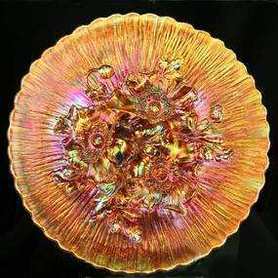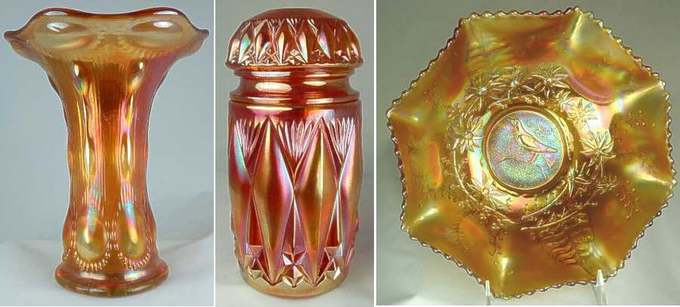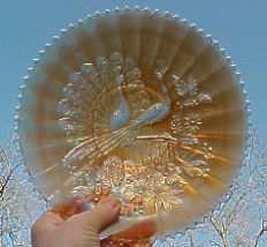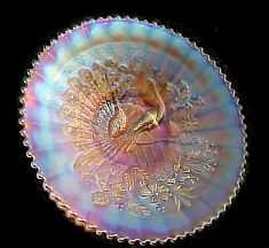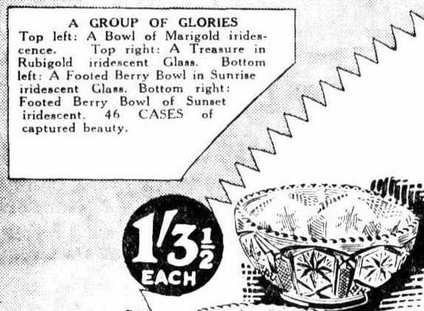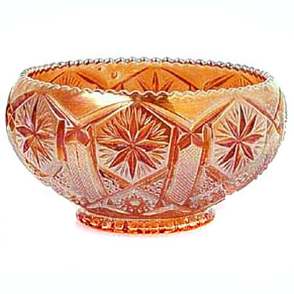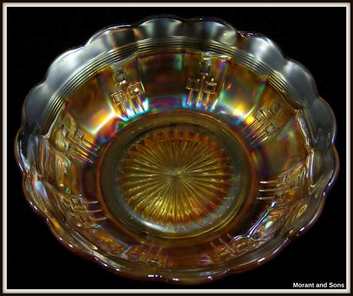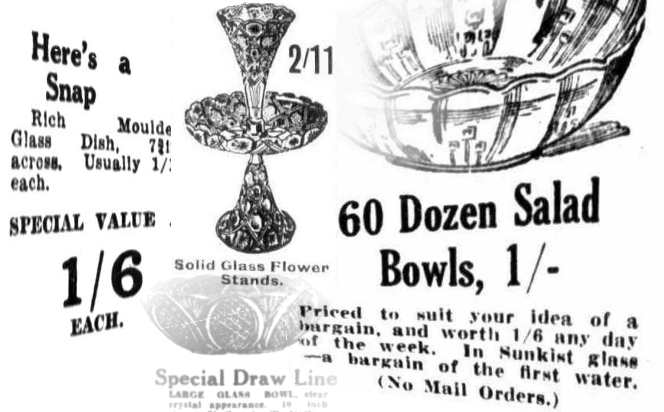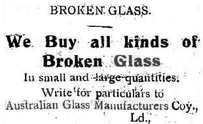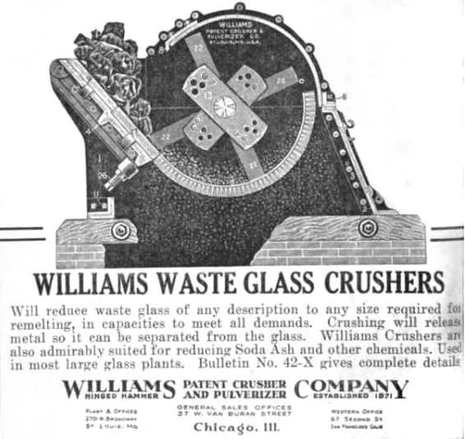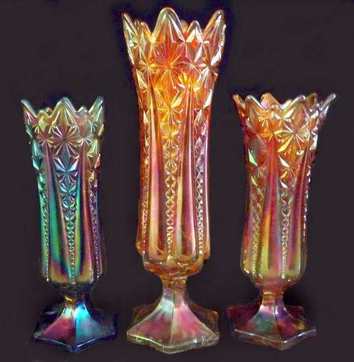NetworK ezine Issue 13. June 2016
by Glen and Stephen Thistlewood
Totally Devoted to Carnival Glass
It’s our first anniversary! Our Carnival journal NetworK was re-launched as a FREE ezine exactly one year ago – and what a fantastic ride our first year has been. A huge number of people all over the world receive NetworK as an ezine, and many more visit NetworK online at carnivalglassnetwork.com Previous issues are posted online to read on demand. In May alone there were some 2000 visits!
We want to thank you all for making it such a phenomenal success.
We are marking the occasion of our first anniversary with a Celebration of Marigold. In a fresh and revealing look at the heart and soul of Carnival Glass, we investigate where it began – with marigold iridescence.
|
Magical Marigold
Marigold: the flowers are known as the “Herb of the Sun” and Mary’s Gold, symbolic of passion and creativity. It’s believed that the earliest use of them was by the Aztecs, who felt they had magical properties. Right: Northwood Poppy Show plate in vibrant marigold. For Carnival collectors, marigold is the one, single colour that not only personifies Carnival but also symbolizes and represents it. Marigold was the first colour used by the Classic Carnival makers, evoking the earlier iridescent glass that originated in Europe and also from Tiffany in the USA. Not always loved, sometimes even scorned, marigold can soar to the heights but can also hit the lows. What exactly is marigold Carnival Glass? Marigold is an orange iridescent effect that is always on a clear (crystal) base glass. Its golden orange colouring comes from the ferric (iron) chloride in the spray that coats the clear glass with a shimmering iridescence. |
Above: marigold Carnival Glass around the world. Imperial's Beaded Bullseye vase (left, USA),
Brockwitz Patricia covered pickle jar (Germany), and Crown Crystal's Magpie 9 inch bowl (Australia).
Brockwitz Patricia covered pickle jar (Germany), and Crown Crystal's Magpie 9 inch bowl (Australia).
The many moods of marigold
|
Marigold has many moods and many shades – even though the method of production is more or less the same. Marigold is always on clear (crystal) glass; you can verify that if you find a part of the piece where the iridescence is absent, such as a collar base or foot. Marigold can have a deep and vibrant red-orange colouring or it can have a pastel effect that shimmers with lime, aqua and pink. It may simply be a middle-of-the-road, marigold (neither vibrant nor pastel) or it can be a pale, “almost there” whisper of lacklustre orange. There are even pieces where the marigold iridescence is found only around the edge, usually on a vase, up at the top - probably a deliberate effect, evoking an earlier Art Glass style, such as that seen on some epergne horns or flower “lilies”). |
Pastel marigold. The background and the light affect how colours are perceived, and Carnival Glass is no exception. The two pictures above are the same plate, Northwood's Peacocks in pastel marigold. Look how the plate shimmers with colour when it’s viewed against a dark background, but then hold it up to a sunlit sky and the colour vanishes … you’re left with just a pale orange.
|
Where did the name marigold come from?
The early glass makers called the colour “Iris”, “iridescent”, “Rubigold” and more – but to the best of our knowledge, none of the glass makers originally gave it the name marigold.
We believe that we have now uncovered the earliest published use (so far) of the term “marigold” for Carnival Glass. Where and when, you ask? You might be surprised … it was Australia in 1925!
Below is an extract from a remarkable ad in an October 1925 Sydney newspaper - the first sentence describes the glass as: “A Bowl of Marigold iridescence.”
You can see the full ad and read the revelations about this fascinating discovery - click on the image above, or go here to read the Story Behind the Glass.
We have a huge amount of information about all the Carnival Glass colours, including marigold in all its shades. Read about Carnival Glass Colours.
“The King of China” – Part Two
We promised you a second bite of the goodies offered by “The King of China”. The scarce beauty shown below is from the Australian Carnival maker, Crown Crystal - a marigold Pin Ups bowl.
You can see the full ad and read the revelations about this fascinating discovery - click on the image above, or go here to read the Story Behind the Glass.
We have a huge amount of information about all the Carnival Glass colours, including marigold in all its shades. Read about Carnival Glass Colours.
“The King of China” – Part Two
We promised you a second bite of the goodies offered by “The King of China”. The scarce beauty shown below is from the Australian Carnival maker, Crown Crystal - a marigold Pin Ups bowl.
A salad bowl in the pattern we now call Pin Ups was advertised “In Sunkist glass” in 192 as shown above, right. Sunkist was, of course, marigold. To see the original ad for the Pin Ups bowl, and some amazing European items that Reub Levy also sold, click on the image above, or read Reub Levy (Part Two).
|
The Story of Cullet What exactly is cullet? The Corning Museum of Glass says that it is (1) Raw glass or pieces of broken glass from a cooled melt, to be used as an ingredient of batch; (2) scrap glass intended for recycling. Cullet is added to the glass “batch” to hasten the melting process and to make it easier to work. So - how did they turn broken and scrap glass into cullet back in the days of Carnival Glass manufacture? Meet the formidable Williams Waste Glass Crusher! The particulars of this formidable sounding machine say that it “will reduce waste glass of any description to any size required for remelting” adding that it was “Used in most large glass plants”. But where did the broken glass for cullet actually come from? Some came from the glassmakers own operation (from items that didn’t turn out right or broke), but interestingly there was a trade in buying broken glass, as shown by ads such as the one above from a 1918 newpaper ad placed by the
|
Australian Glass Manufacturers Company, which Crown Crystal became part of.
We also discovered a fascinating snippet of information in a 1903newspaper report, entitled “Tons of Broken Glass”. It stated that “Every year there are picked up in the streets of London alone something like two thousand tons of glass – “cullet” as it is called by the pickers and sorters.” The thought of these “pickers and sorters” walking the streets of London over a century ago, gathering up glass, made us gasp. We hope they all had sturdy gloves, but somehow we suspect they didn’t!
We also discovered a fascinating snippet of information in a 1903newspaper report, entitled “Tons of Broken Glass”. It stated that “Every year there are picked up in the streets of London alone something like two thousand tons of glass – “cullet” as it is called by the pickers and sorters.” The thought of these “pickers and sorters” walking the streets of London over a century ago, gathering up glass, made us gasp. We hope they all had sturdy gloves, but somehow we suspect they didn’t!
Marigold Rarity Found
|
The German Carnival Glass maker, Brockwitz, produced many beautiful vases, and one of the more familiar ones is Footed Prisms (also called Footed Prism Panels). The marigold 9 inch vase is seen quite often, while the blue 9 inch version is extremely hard to find. But did you know there was a taller version? The vase was illustrated in two sizes, 24cm and 31cm (9 and 12 inches) in the Brockwitz 1915 catalogue, however the larger size was not shown in later 1930s catalogues. A 12 inch marigold example has recently been found – only the second to be reported in this larger size. Left: a trio of Brockwitz's Footed Prisms vases. The 9 inch version in blue and marigold, and the very rare 12 inch version in marigold. |
Feedback
Thank you all so much for the great feedback we’ve had for both the recent NetworK Special as well as for NetworK #12.
We love hearing from you, so please keep your comments and emails coming in. We’d like to share with you Carl Chapman’s comments, as they are an important piece of Carnival Glass history. Carl wrote to us after reading our recent NetworK Special on the Carnival Pioneers:
“As a young boy, right after WW II, I remember going to the Florida State Fair in Tampa and seeing booths of chance where you could pitch a dime (10c.) to tables stacked with Carnival Glass. If the dime stayed in the glass you got to keep the piece, I can only imagine how many pieces were damaged when the coin hit the glass and bounced from piece to piece. The trick was to lob the coin to the top tier of glass and hope the dime ended up in one of the lower pieces. It was a “carnival” favorite pastime for the girls. I was probably eight to ten years old at the time.”
|
Who remembers these fairground attractions in the 1950s? Take a nostalgic trip on Trigger or the Space Patrol – what fun they were. The ad on the right is from The Billboard in 1953. In the early 1950s, ads such as this, aimed at concessionaires and fairground tradesmen, included a long list of items available for purchase. In a typical ad for “Merchandise You Have Been Looking For”, the list includes toys, decorated tinware, flying birds and “Every kind of Glassware”. |
We’d like to close our First Anniversary issue of NetworK with our heartfelt thanks to everyone who has joined us in this exciting venture, contributing to its success and providing invaluable content, feedback, encouragement and support.

